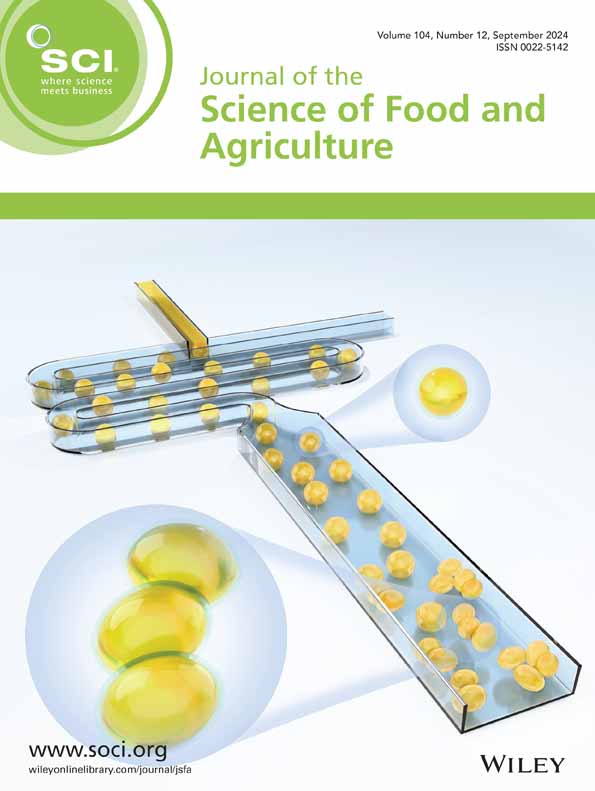求助PDF
{"title":"对61个北美木瓜品种果实采后生化、生物物理和生物学特性进行了综述。","authors":"Robert G Brannan","doi":"10.1002/jsfa.70115","DOIUrl":null,"url":null,"abstract":"<p><p>Fruit from the North American pawpaw (Asimina triloba) is unfamiliar to many as a food crop and botanically unusual because it is the northernmost genus and only temperate member of the tropical Annonaceae family. It is the largest edible fruit native to North America. Wild or unnamed cultivars of pawpaw account for much of the pawpaw that is sold in the United States, however, there are over 160 named cultivars of pawpaw. Only a few hundred papers accounts for the entirety of the published research on pawpaw, and the majority of that research is focused on preharvest growth characteristics. Manuscripts that exist about biochemical, biological, and biophysical properties of pawpaw tend to not identify the cultivars that were assayed. This review presents an overview of biochemical, biological, and biophysical properties of named cultivars of the North American pawpaw (Asimina triloba). Sixty-one named pawpaw cultivars were analyzed and compared. The biochemical, biological, and biophysical properties reported in this study provide a strong basis to the view the pawpaw through a wider lens that could lead to breakthroughs in the development of new food products, functional insights, and processing technologies. Understanding the differences in quality attributes between pawpaw cultivars can aid in improving this underutilized fruit crop. © 2025 The Author(s). Journal of the Science of Food and Agriculture published by John Wiley & Sons Ltd on behalf of Society of Chemical Industry.</p>","PeriodicalId":17725,"journal":{"name":"Journal of the Science of Food and Agriculture","volume":" ","pages":""},"PeriodicalIF":3.5000,"publicationDate":"2025-08-29","publicationTypes":"Journal Article","fieldsOfStudy":null,"isOpenAccess":false,"openAccessPdf":"","citationCount":"0","resultStr":"{\"title\":\"A review of the postharvest biochemical, biophysical and biological properties of 61 cultivars of North American pawpaw (Asimina triloba) fruit.\",\"authors\":\"Robert G Brannan\",\"doi\":\"10.1002/jsfa.70115\",\"DOIUrl\":null,\"url\":null,\"abstract\":\"<p><p>Fruit from the North American pawpaw (Asimina triloba) is unfamiliar to many as a food crop and botanically unusual because it is the northernmost genus and only temperate member of the tropical Annonaceae family. It is the largest edible fruit native to North America. Wild or unnamed cultivars of pawpaw account for much of the pawpaw that is sold in the United States, however, there are over 160 named cultivars of pawpaw. Only a few hundred papers accounts for the entirety of the published research on pawpaw, and the majority of that research is focused on preharvest growth characteristics. Manuscripts that exist about biochemical, biological, and biophysical properties of pawpaw tend to not identify the cultivars that were assayed. This review presents an overview of biochemical, biological, and biophysical properties of named cultivars of the North American pawpaw (Asimina triloba). Sixty-one named pawpaw cultivars were analyzed and compared. The biochemical, biological, and biophysical properties reported in this study provide a strong basis to the view the pawpaw through a wider lens that could lead to breakthroughs in the development of new food products, functional insights, and processing technologies. Understanding the differences in quality attributes between pawpaw cultivars can aid in improving this underutilized fruit crop. © 2025 The Author(s). Journal of the Science of Food and Agriculture published by John Wiley & Sons Ltd on behalf of Society of Chemical Industry.</p>\",\"PeriodicalId\":17725,\"journal\":{\"name\":\"Journal of the Science of Food and Agriculture\",\"volume\":\" \",\"pages\":\"\"},\"PeriodicalIF\":3.5000,\"publicationDate\":\"2025-08-29\",\"publicationTypes\":\"Journal Article\",\"fieldsOfStudy\":null,\"isOpenAccess\":false,\"openAccessPdf\":\"\",\"citationCount\":\"0\",\"resultStr\":null,\"platform\":\"Semanticscholar\",\"paperid\":null,\"PeriodicalName\":\"Journal of the Science of Food and Agriculture\",\"FirstCategoryId\":\"97\",\"ListUrlMain\":\"https://doi.org/10.1002/jsfa.70115\",\"RegionNum\":2,\"RegionCategory\":\"农林科学\",\"ArticlePicture\":[],\"TitleCN\":null,\"AbstractTextCN\":null,\"PMCID\":null,\"EPubDate\":\"\",\"PubModel\":\"\",\"JCR\":\"Q1\",\"JCRName\":\"AGRICULTURE, MULTIDISCIPLINARY\",\"Score\":null,\"Total\":0}","platform":"Semanticscholar","paperid":null,"PeriodicalName":"Journal of the Science of Food and Agriculture","FirstCategoryId":"97","ListUrlMain":"https://doi.org/10.1002/jsfa.70115","RegionNum":2,"RegionCategory":"农林科学","ArticlePicture":[],"TitleCN":null,"AbstractTextCN":null,"PMCID":null,"EPubDate":"","PubModel":"","JCR":"Q1","JCRName":"AGRICULTURE, MULTIDISCIPLINARY","Score":null,"Total":0}
引用次数: 0
引用
批量引用

 求助内容:
求助内容: 应助结果提醒方式:
应助结果提醒方式:


